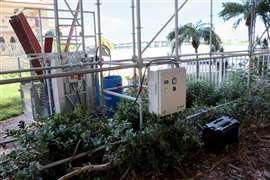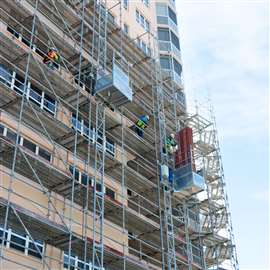Innovation in motion - a Floridian case study

Partner Content produced by KHL Content Studio
September 09, 2024
When historic Hurricane Ian barreled its way through Florida’s southwest Gulf Coast in late September 2022, very few structures were left unscathed, with many either destroyed completely, or left in desperate need of repair and renovation.
 Trekker utilized two Alba MC 250 material hoists from Bee Access to erect scaffolding for the Ft. Myers condo renovation
Trekker utilized two Alba MC 250 material hoists from Bee Access to erect scaffolding for the Ft. Myers condo renovation
Even two years later, many parts of the city of Ft. Myers and the surrounding areas continue to recover—especially those structures facing the mostly picturesque, but occasionally hazardous, Gulf of Mexico.
As to be expected, condominium (condo) buildings dot the landscape in a place as favorably located as the southwest coast of Florida. And when a storm comes through, especially one as destructive as Ian, those in need of a makeover need it done as efficiently and affordably as possible.
Among a list of additional jobsite priorities, Miami (Fla.)-based Trekker Distributors understood these two as principal to the initial phase of said makeover for a particular condo building renovation they were positioned to set up scaffolding for in July 2024.
They also knew that renovating a condo building in a high-density urban environment like south Florida presents a host of challenges. The need to skillfully transport heavy, awkward materials to elevated work areas without disrupting the surrounding community or compromising safety is paramount.
When time is money
Moreover, the Trekker team was tasked with adhering to strict project timelines. However, according to Micah Turner, access division manager at Trekker Group, finding the right equipment that could offer the necessary lifting capacity, safety features, and ease of operation wasn’t as challenging a task as it might have looked on paper.
 The MC 250 pivoting basket can swing 90 degrees for safe & easy unloading of materials
The MC 250 pivoting basket can swing 90 degrees for safe & easy unloading of materials
“We required a material hoist that was not only robust and reliable, but also compact enough to fit into the tight confines of this urban jobsite,” he explains. “Fortunately, I knew where to look.”
Trekker had recently utilized two Alba MC 250 material hoists from Bee Access (Bee) on a project involving the tallest building in Orange Beach, Alabama. “We had some scaffolding that got us up to the first level of that high-rise, but we needed another two hundred fifty feet above that,”
Turner recalls. “We’d used some other solutions, but they wouldn’t get us up to the height we needed. So, we met with Bee and asked them what they had that could help us with this issue.”
Turner’s contact at Bee showed him the Alba MC 250. “It ended up being a perfect fit for what we needed there,” he says.
So, when Turner needed a solution for the Gulf Coast condo job, he set up a visit (Bee Access is located just north of Trekker in West Palm Beach, Florida).
“They showed me the new MC 250 with the pivoting basket and battery solution,” he notes. “It was even more practical than the others we’ve used. It carries more weight and fits in tighter spaces.
 When building power is not an option, Bee Access has battery powered solutions
When building power is not an option, Bee Access has battery powered solutions
“And it’s a standup basket that rotates a hundred and eighty degrees—so it really hit all the items we were looking for in a hoist to make our jobs easier and more efficient on this project.”
Game changer
Comprising over 60 years of history, Puerto Rico’s Trekker Group formed Trekker Distributors in 2012, ultimately setting up offices in Miami and Haines City (Fla.). And over the last few years, according to Turner, they’ve seen continued growth in the scaffold division.
“In fact, it looks like our scaffold division will be the largest part of our operations in the next three years,” he points out—adding that such a realization likely means a lot more work with Bee.
“We do a lot of high-rise buildings, hurricane restoration, etc., but being a smaller company, we have to set ourselves apart—come up with out-of-the-box solutions—which leads to seeking out innovative materials and solutions that allow us to do that.”
The Alba MC 250 has proven to be another perfect fit for Turner on the condo renovation project.
“We’re providing the scaffolding around the entire building—14 floors if you count the roof slab,” he confirms. “It’s a complete exterior renovation—while people are still living in it.”
 The use of two MC 250 units allowed for continuous scaffold erection and minimal downtime
The use of two MC 250 units allowed for continuous scaffold erection and minimal downtime
Normally, adds Turner, such a project will require 20 or more workers to set up. “Or you’re going to use a hoist that moves less material, or is wire-rope driven. Whereas we’ve got these two MC 250s—side by side. While one of them is up in the air and the guys are unloading, the other one is down on the ground getting loaded up.”
According to Turner, his crew finished the first half of the building (165 linear feet by 130 feet high) five days ahead of schedule, with just seven workers.
“The MC 250 has been an invaluable resource—we finished faster and with less manpower,” he says, emphasizing that the savings has undoubtedly increased their margins on the job.
The successful deployment of the hoist comes as no surprise to vice president of sales at Bee, Don Allen, who says, “Enhanced safety, increased efficiency, boosted productivity, cost savings—that’s what the MC 250 brings to the table.
“It provides the installers with a huge increase in production—probably 30 to 40 percent. By mechanizing the process, companies can reduce their labor costs. On a large, fixed-cost job, you’re paying for the unit on one project. And the safety problem it solves probably can’t be measured, but it’s game changing.”
All-round solution
Produced in Spain through Bee’s manufacturing partner, Alba, the MC 250 represents an innovative response to customer feedback.
Compatible with all brands of tube and coupler, system, and frame scaffolding on the market, it can be equipped with different interchangeable carriers depending on the type of loads to be lifted or the requirements of the job. It also boasts a 550-pound load capacity, a rack and pinion drive, a soft start and stop, as well as industry-leading safety features like upper/lower limit switches, an overspeed safety device, and a controlled-descent device.
“Essentially, we took a product that already existed at Bee, listened to our customers, and worked with Alba to make it more user-friendly,” says Allen. “Less components in the field, minimal parts. Six different carriers customers can use. Bigger basket—the ability to pivot all the way around. And, of course, the batteries. It’s adaptable, reliable and cost-effective.”
Turner agrees. “Case in point—we bid on a job and the board initially baulked at the price. It’s an insurance job. I told them I’d look into it, then went to Bee. We talked about the MC 250 as a solution because it goes higher, carries more weight, and is great in tight spaces. It’s rack and pinion. And power is always an issue with an occupied building. But Bee let us try the batteries out—as a test run—and they’ve exceeded our expectations.”
As a result of its success with the MC 250, Turner was able to lower Trekker’s price on the Florida condo project, and ultimately got the job. “At the end of the day, I’ve tried pretty much every material hoist on the market,” he says. “Each of them has their strengths. But the MC 250 from Bee—with the pivoting basket and the battery innovation—is the best all-around solution out there for what we’re doing right now. Simply put: it’s making us better. And this job serves as proof of that fact.”
--------
All images courtesy Bee Access
--------
This article was produced by KHL’s Content Studio, in partnership with experts from Bee Access
STAY CONNECTED



Receive the information you need when you need it through our world-leading magazines, newsletters and daily briefings.
CONNECT WITH THE TEAM








